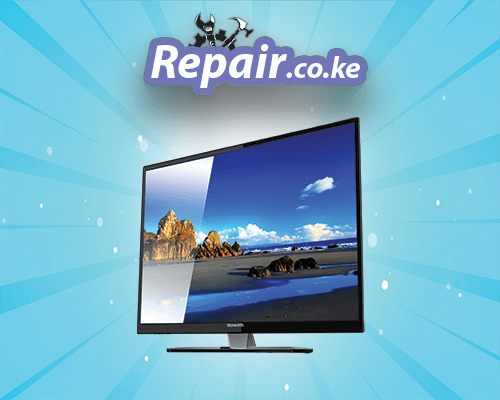Television Repair Services in Thika and Nairobi, and TV parts replacement
Television repair services play a crucial role in ensuring that your TV functions optimally and lasts for an extended period. When your television encounters issues, seeking professional repair services can save you money and prevent unnecessary waste. Knowledgeable technicians can diagnose and fix a wide range of problems, restoring your TV to its original performance. Here is a list of common television repair services:
- Screen Replacement: If your TV’s screen is cracked, damaged, or displaying distorted images, a skilled technician can replace the screen with a new one. This service is commonly provided for LED, LCD, OLED, and plasma TVs.
- Power Issues: When your television won’t turn on or experiences intermittent power problems, technicians can diagnose and repair issues related to the power supply, circuit boards, or faulty components.
- Audio Problems: If you’re facing issues with the TV’s sound, such as no audio, distorted sound, or low volume, professionals can troubleshoot the speakers, audio circuitry, or connections to fix the problem.
- Video Issues: Problems with the TV’s video output, like flickering, no picture, or color distortion, can be addressed by diagnosing and repairing issues with the video processing circuits, T-con board, or other related components.
- Backlight Replacement: For LED TVs with backlighting problems, technicians can replace faulty LEDs or the entire backlight assembly to resolve dimming or uneven brightness issues.
- HDMI Port Repair: If your TV’s HDMI ports are not functioning correctly or not recognizing devices, technicians can repair or replace damaged HDMI ports.
- Remote Control Issues: Troubles with your TV’s remote control functionality can be fixed by repairing or reprogramming the remote control or addressing any communication issues with the TV’s infrared sensor.
- Tuning and Channel Problems: Technicians can resolve issues related to channel reception, tuning errors, or issues with the TV’s internal tuner.
- Wi-Fi and Smart TV Problems: For smart TVs with internet connectivity issues, technicians can troubleshoot and repair Wi-Fi or Ethernet connectivity problems.
- Software Updates and Firmware Fixes: Regular software updates and firmware fixes can improve TV performance and address bugs or issues related to the TV’s operating system.
- Cable and Connector Repairs: If your TV has damaged or loose cables, technicians can repair or replace them to restore proper connections.
- General Maintenance and Cleaning: Regular maintenance and cleaning of your TV can prevent dust accumulation, overheating, and other potential issues.
It’s essential to note that not all television repair services are feasible for every model and brand. Some older or less common TV models might have limited repair options due to the availability of spare parts. Additionally, in some cases, the cost of repair might outweigh the benefits, and it might be more practical to consider purchasing a new TV.
When seeking television repair services, it’s crucial to rely on reputable and experienced technicians to ensure proper diagnosis, reliable repairs, and safety. Always inquire about warranties, service guarantees, and repair costs before proceeding with the repair work.
Television Screen Replacement Services: Reasons and Types
Television screen replacement services are essential for addressing various issues that may arise with a TV’s display. As televisions have evolved over the years, different types of screens have been developed, each with unique characteristics and potential problems. Here, we’ll explore the reasons a television screen may need to be replaced and the different types of TV screens that can be replaced.
Reasons for Television Screen Replacement:
- Physical Damage: Accidental impact or mishandling can lead to cracks, shattered glass, or other physical damage to the TV screen. Such damage often necessitates screen replacement to restore picture quality.
- Dead Pixels: Dead pixels are pixels that fail to display any color or remain permanently black, resulting in visible dark spots on the screen. If dead pixels are widespread, screen replacement might be the only viable solution.
- Lines or Banding: Horizontal or vertical lines on the screen, or banding (uneven brightness or color distribution), can be indicative of a faulty screen, requiring replacement.
- Burn-in/Image Retention: For older plasma and OLED TVs, static images displayed for extended periods can lead to burn-in, leaving faint but persistent ghost images on the screen. In such cases, replacing the screen may be the best option.
- Backlight Issues: For LED and LCD TVs, problems with the backlight can result in dark or flickering areas on the screen, impairing the viewing experience and necessitating screen replacement.
- Water Damage: Exposure to water or excessive moisture can cause irreversible damage to TV screens, often requiring replacement.
Different Types of TV Screens that can be Replaced:
- LCD (Liquid Crystal Display): LCD screens are common in modern televisions. They work by manipulating liquid crystals to control the amount of light passing through, producing the image. If an LCD screen is physically damaged, has dead pixels, or suffers from backlight issues, it may need replacement.
- LED (Light Emitting Diode): LED TVs use LED backlighting behind an LCD panel to illuminate the display. While LED TVs are still considered LCD TVs, they offer improved brightness and energy efficiency. Problems with the LED backlighting can necessitate screen replacement.
- OLED (Organic Light Emitting Diode): OLED TVs use organic compounds that emit light when an electric current is applied. OLED screens are known for their vibrant colors, deep blacks, and thin form factor. However, issues like burn-in or physical damage may require screen replacement.
- Plasma: Plasma TVs have largely been phased out, but some may still require screen replacement due to burn-in or other screen-related problems.
- QLED (Quantum Dot LED): QLED TVs utilize quantum dot technology with LED backlighting to enhance color and brightness. Like standard LED TVs, QLED TVs might need screen replacement if they encounter issues with the display.
- MicroLED: MicroLED TVs are a newer technology that uses microscopic LED modules to create the display. As this technology becomes more widespread, screen replacement options may become available.
It’s important to note that TV screen replacement can be a delicate and complex process, often requiring professional expertise to ensure a successful outcome. If your television screen is experiencing any of the mentioned issues, seeking the assistance of qualified technicians or authorized service centers is highly recommended to assess the problem and provide appropriate solutions.




